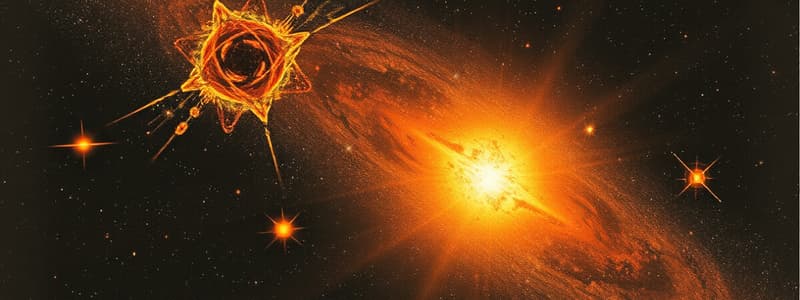Podcast
Questions and Answers
What does stellar classification refer to in astronomy?
What does stellar classification refer to in astronomy?
- Classification of stars based on their spectral characteristics (correct)
- Classification of stars based on their color
- Classification of galaxies based on their shape
- Classification of planets based on their size
What percentage of all stars are included in the main sequence?
What percentage of all stars are included in the main sequence?
more than 90 percent
What are O class stars?
What are O class stars?
A main-sequence star of spectral type O and luminosity class V
What is a B class star?
What is a B class star?
What characterizes an A type star?
What characterizes an A type star?
What is a G type star also known as?
What is a G type star also known as?
What is a brown dwarf?
What is a brown dwarf?
Define Wolf-Rayet stars.
Define Wolf-Rayet stars.
What is a subgiant star?
What is a subgiant star?
What is the definition of a red giant?
What is the definition of a red giant?
What is a blue supergiant?
What is a blue supergiant?
Which of the following is true about carbon stars?
Which of the following is true about carbon stars?
Flashcards are hidden until you start studying
Study Notes
Stellar Classification
- Stellar classification categorizes stars based on their spectral characteristics.
- More than 90 percent of all stars are found on the main sequence, a prominent diagonal area on the H-R diagram.
Main Sequence Stars
- O-class stars: Hot, massive stars with high luminosity (spectral type O, luminosity class V).
- B-class stars: Hydrogen-burning stars of spectral type B (luminosity class V).
- A-type stars: Exhibits strong hydrogen absorption lines.
- F-type stars: Hydrogen-fusing stars of spectral type F (luminosity class V).
- G-type stars: Often known as yellow dwarfs, these stars are spectral type G.
- K-type stars: Known as K dwarfs or orange dwarfs, these are hydrogen-burning stars of spectral type K.
- M-type stars: Known as red dwarfs, they are the smallest and coolest stars on the main sequence.
Advanced Stellar Types
- Brown dwarfs: "Failed" stars lacking sufficient mass for nuclear fusion.
- Wolf-Rayet stars: Identified over 220, very hot (25,000 to 100,000 K), rapidly losing mass (over 10^-5 solar masses/year), with extreme wind speeds (800 to 3000+ km/s).
- OB stars: Hot, massive stars (spectral types O or early B) that form OB associations.
Subdwarf Classification
- Subdwarf (sd): Stars with luminosity class VI, exhibiting lower luminosity than regular main-sequence stars.
- Subdwarf O stars (sdO): Hot, low-mass stars.
- Subdwarf B stars (sdB): A specific kind of subdwarf star with spectral type B.
Stellar Evolution Stages
- Subgiants: Intermediate stars between main-sequence and giants with inert helium cores and hydrogen-fusing shells.
- Giants: Large, bright stars with exhausted hydrogen in their cores.
- Blue giants: Extremely hot, large, and bright stars.
- Yellow giants: Luminous giant stars of low or intermediate mass in later evolutionary phases.
- Red giants: Large, reddish stars at a late life stage.
Supergiants
- Bright giants: Highly evolved massive stars, classified as Luminosity Class II.
- Supergiants: Very large stars, brighter than giants, despite being relatively cool.
- Blue supergiants: Largest and hottest stars located at the upper-left end of the main sequence.
- Red supergiants: Massive stars during their expansion phase, becoming very bright.
- Yellow supergiants: Stars, typically of spectral type F or G, classified as supergiants.
Hypergiants
- Hypergiants: Extremely massive and luminous stars that lose mass rapidly due to their size.
- Yellow hypergiants: Massive stars with extended atmospheres and significant mass loss, possessing spectral classes from A to K.
Unique Stellar Types
- Carbon stars: Red giants with strong absorption lines of carbon.
- S-type stars: Cool giants with equal amounts of carbon and oxygen in their atmospheres.
- CN stars: Stars exhibiting unusually strong cyanogen bands in their spectra.
Studying That Suits You
Use AI to generate personalized quizzes and flashcards to suit your learning preferences.




